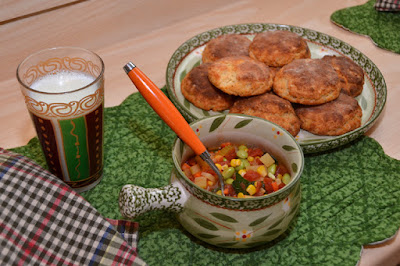I like a book where I'm challenged to try new things and this 2020 book did just that. After seeing the price sticker on a jar of fermented sauerkraut, I decided to make my own. The recipe instructions were clear and the preparation time was little. And I love the result.
The book has a good review of what to look for on labels before buying-a shoppers' guide. The recipes include both prebiotic and probiotic ingredients. The recipes include a variety of whole grains, fruits and vegetables and recipes with little added sugar. There is a nice assortment of proteins, including eggs, legumes, dry beans, seafood, chicken and pork. The recipes have a nice description and tips for getting the most healthful effect.
I was reminded to read the label on the yogurt I buy and look for live active cultures-added after pasteurization. I was encouraged to buy raw cheddar cheese, aged for over 6 months. I did buy miso paste and will continue to use it. The recipe tips included adding the miso paste near the end of cooking.
My one disappointment is that the sodium in recipes is high, though there are few processed foods. I do want to add that the serving of fermented cabbage is only 1/4 cup. I loved that the recipe was a "small batch".
Here's what I tested:
Breakfast
Fermented Cabbage and Grain Bowl
Drinks and Snacks
Protein Smoothie (made with cultured cottage cheese)
Dressing and Main Dish
Citrus Miso Salmon
Soups
Miso Noodle Soup
(I used my own homemade noodles which have wheat bran-another prebiotic fiber)
Desserts
No Bake Cheesecake (made with cultured cottage cheese)
Caramelized Pears (with Maple Greek Yogurt)
My lunches included melted raw and aged cheddar on my own whole grain sourdough toast.
Thank
you Quarto Group for the complimentary review copy. The above post and
pictures are my own. I received no other compensation for this review,
other than the pleasure of an enjoyable read and eating experience!
More than 100 delectable, natural, and supplement-free probiotic recipes
The Probiotic Kitchen

For optimum probiotic nutrition, it's time to say goodbye to supplements and pills and to bring
all-natural, all-delicious, real-food probiotic (and prebiotic) meals into your life.
Mainstream doctors and nutritionists firmly agree that probiotics are
essential for everyday health and nutrition. Probiotics add “good
bacteria” to the human gut. They work by crowding out “bad bacteria” and
by fostering the absorption of nutrients through the intestinal
walls. Everyone needs probiotics, just as they also need prebiotics,
which make probiotics work. Probiotics also aid in the relief of chronic
health issues, such as irritable bowel syndrome (IBS), as well
as occasional belly discomfort, and are recommended for a growing range
of other uses, like the management of type 2 diabetes. They are
generally agreed to have anti-inflammatory properties, too.
Kelli Foster's
The Probiotic Kitchen makes
probiotic cooking easier and tastier than it's ever been before. As
they do with vitamins and minerals, doctors recommend naturally
occurring probiotics in real food over artificial supplements. In
earlier books on the subject, almost all of the probiotic foods were
fermented things like pickles, kimchi, kombucha, and the like. But
recent discoveries have greatly expanded the range of foods that now are
known to be rich in probiotics. These include cheeses, green peas,
and even chocolate, among many others. Foster's enticing and reliable
book covers fermented foods, to be sure, but also adds loads of recipes
for more familiar and more versatile ingredients—more than 100
recipes in all, each one as delectable as the next.
About the Author
Kelli Foster is a staff writer and editor for The Kitchn, which more than twenty million people visit each month, and the author of Buddha Bowls. A graduate of the French Culinary Institute, she lives in New York City.
The Probiotic Kitchen
By: Kelli Foster
On-Sale Date: December 17, 2019
$24.99 US · $32.99 CAN · 208 pages · Paperback Book
ISBN: 978-1-55832-989-8
Harvard Common Press, an imprint of The Quarto Group
For more information or to request recipes or images from the book, please contact
Todd Conly at 978-282-3511 OR todd.conly@quarto.com.





















 For optimum probiotic nutrition, it's time to say goodbye to supplements and pills and to bring all-natural, all-delicious, real-food probiotic (and prebiotic) meals into your life.
For optimum probiotic nutrition, it's time to say goodbye to supplements and pills and to bring all-natural, all-delicious, real-food probiotic (and prebiotic) meals into your life.

































